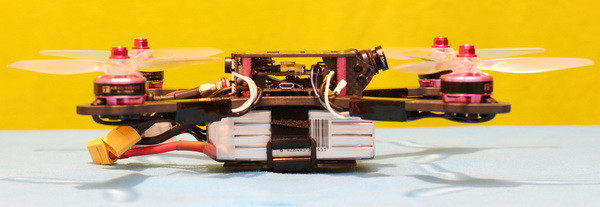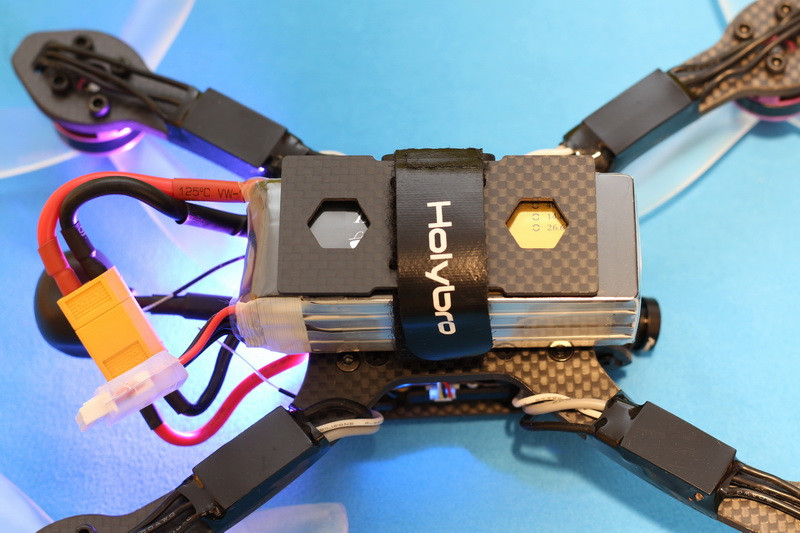Tattu 1800mah 4S 75C Battery review- long flight time for FPV drones
Nov 21st 2017
Today we’re going to find out how long it takes to charge the Tattu 4s 1800mah 75c and what the real world flight time is, in comparison to 1300 mAh batteries which are more common for racing drones.
When it comes to racing quadcopters, flight time is not as important as it is in the case of cruising drones. More important is the take-off weight and you need to keep it as low as possible. More weight means less agility and lower speed.
By comparison, the Tattu 4s 1800mah 75c has 193 grams and the Tattu R-Line 4s 1300mAh has only 165 grams. I’m very curious to find out if the extra capacity (500 mAh) will counteract the increased weight.

 Battery pack measures around 90 x 33 x 30 mm (L, W, H). Due to the aluminium envelope, the Tattu 1800 mAh weights a bit more than other 4s Li-Po batteries with same capacity. After a bit of research I found out that this producing technique provides not just better heat dissipation and impact resistance, but also compression, in order to minimize puffing during high discharge.
Battery pack measures around 90 x 33 x 30 mm (L, W, H). Due to the aluminium envelope, the Tattu 1800 mAh weights a bit more than other 4s Li-Po batteries with same capacity. After a bit of research I found out that this producing technique provides not just better heat dissipation and impact resistance, but also compression, in order to minimize puffing during high discharge.
 Firstly, I fully discharged both batteries, rest them for 1 hour, then charged them up at 0.5 A. As you can see in the comparison table bellow, the R-Line 95C finished the discharge process more balanced. At the end of charging, both batteries were well balanced. The two batteries remained cold during the charge.
Firstly, I fully discharged both batteries, rest them for 1 hour, then charged them up at 0.5 A. As you can see in the comparison table bellow, the R-Line 95C finished the discharge process more balanced. At the end of charging, both batteries were well balanced. The two batteries remained cold during the charge.
 In order to test how these two behave in the real world I used my Kopis 1 racing drone. I tried to fly them with the similar amount of throttle in order to get the most accurate results.
In order to test how these two behave in the real world I used my Kopis 1 racing drone. I tried to fly them with the similar amount of throttle in order to get the most accurate results.
 As I'm not a Pro racing pilot, I haven't noticed significant performance dropping from 95C to 75C while flying at top speed. Also, the extra weight doesn't seem to be an issue for the 2450KV brush-less motors. Frankly, it's hard to get an objective measurement of true "C" rating without professional tools.
I ended my test flights when OSD shown 14 volts (~ 3.5V/cell). While my flight with the 1300 mAh LiPo lasted about 5 minutes, the one with the Tattu 4s 1800 mah ended after almost 7 minutes. Unfortunately, I forgot home my infrared thermometer and I can’t confirm if motors and ESCs became hotter after the longer flight.
Those who need extra flight time for their FPV racing drone, this Tattu 1800 mAh LiPo can be ordered from EU and USA (delivery from both, EU and US, is available). Now genstattu Black Friday Sale coming soon. Begins 22nd and ends 30th Nov. Don’t miss! More the biggest sale is HERE
As I'm not a Pro racing pilot, I haven't noticed significant performance dropping from 95C to 75C while flying at top speed. Also, the extra weight doesn't seem to be an issue for the 2450KV brush-less motors. Frankly, it's hard to get an objective measurement of true "C" rating without professional tools.
I ended my test flights when OSD shown 14 volts (~ 3.5V/cell). While my flight with the 1300 mAh LiPo lasted about 5 minutes, the one with the Tattu 4s 1800 mah ended after almost 7 minutes. Unfortunately, I forgot home my infrared thermometer and I can’t confirm if motors and ESCs became hotter after the longer flight.
Those who need extra flight time for their FPV racing drone, this Tattu 1800 mAh LiPo can be ordered from EU and USA (delivery from both, EU and US, is available). Now genstattu Black Friday Sale coming soon. Begins 22nd and ends 30th Nov. Don’t miss! More the biggest sale is HERE







Review of the Tattu 4s 1800 mAh 75C Li-Po battery
Although I received the Li-Po about a month ago, only now I had the time and mood to review it. You know, battery testing/review is pretty time consuming. Battery comes well packed with charging plug protector and safety instruction. At first look it seems very well made with good quality terminals. Battery pack measures around 90 x 33 x 30 mm (L, W, H). Due to the aluminium envelope, the Tattu 1800 mAh weights a bit more than other 4s Li-Po batteries with same capacity. After a bit of research I found out that this producing technique provides not just better heat dissipation and impact resistance, but also compression, in order to minimize puffing during high discharge.
Battery pack measures around 90 x 33 x 30 mm (L, W, H). Due to the aluminium envelope, the Tattu 1800 mAh weights a bit more than other 4s Li-Po batteries with same capacity. After a bit of research I found out that this producing technique provides not just better heat dissipation and impact resistance, but also compression, in order to minimize puffing during high discharge.
Tattu 4s 1800 mAh 75C battery technical specs
- Suitable for FPV racing drones; - Minimum of 1800 mAh storage capacity; - 4 cells of 3.7v. Total voltage of 14.8V; - Total power of ~ 26.64 Wh; - Up to 5C charging rate (do not exceed this value!); - High discharge rate (75C); - Max Cont Current of 135 A; - Maximum burst discharge rate of 150C; - Max Burst Current of 270 A; - JST-XH charging plug; - XT60 discharge (drone) plug; - Net Weight: 198 grams; - Dimensions: 90.30 x 33.27 x 29.90 mm (L W H). Battery came about half charged (48%), which is recommended for storing. I measured 15.34V on the XT60 plug. Cell 1 – 3.83V, Cell 2 – 3.845, Cell 3 – 3.83V and Cell 4 – 3.83V.Is it worth to upgrade from 1300mAh to 1800mAh?
In order to make a fair compassion I used same charger (SkyRC iMAX B6 Mini) with same settings. Both batteries I used for the test had less than 10 charging cycles. Firstly, I fully discharged both batteries, rest them for 1 hour, then charged them up at 0.5 A. As you can see in the comparison table bellow, the R-Line 95C finished the discharge process more balanced. At the end of charging, both batteries were well balanced. The two batteries remained cold during the charge.
Firstly, I fully discharged both batteries, rest them for 1 hour, then charged them up at 0.5 A. As you can see in the comparison table bellow, the R-Line 95C finished the discharge process more balanced. At the end of charging, both batteries were well balanced. The two batteries remained cold during the charge.
 In order to test how these two behave in the real world I used my Kopis 1 racing drone. I tried to fly them with the similar amount of throttle in order to get the most accurate results.
In order to test how these two behave in the real world I used my Kopis 1 racing drone. I tried to fly them with the similar amount of throttle in order to get the most accurate results.
 As I'm not a Pro racing pilot, I haven't noticed significant performance dropping from 95C to 75C while flying at top speed. Also, the extra weight doesn't seem to be an issue for the 2450KV brush-less motors. Frankly, it's hard to get an objective measurement of true "C" rating without professional tools.
I ended my test flights when OSD shown 14 volts (~ 3.5V/cell). While my flight with the 1300 mAh LiPo lasted about 5 minutes, the one with the Tattu 4s 1800 mah ended after almost 7 minutes. Unfortunately, I forgot home my infrared thermometer and I can’t confirm if motors and ESCs became hotter after the longer flight.
Those who need extra flight time for their FPV racing drone, this Tattu 1800 mAh LiPo can be ordered from EU and USA (delivery from both, EU and US, is available). Now genstattu Black Friday Sale coming soon. Begins 22nd and ends 30th Nov. Don’t miss! More the biggest sale is HERE
As I'm not a Pro racing pilot, I haven't noticed significant performance dropping from 95C to 75C while flying at top speed. Also, the extra weight doesn't seem to be an issue for the 2450KV brush-less motors. Frankly, it's hard to get an objective measurement of true "C" rating without professional tools.
I ended my test flights when OSD shown 14 volts (~ 3.5V/cell). While my flight with the 1300 mAh LiPo lasted about 5 minutes, the one with the Tattu 4s 1800 mah ended after almost 7 minutes. Unfortunately, I forgot home my infrared thermometer and I can’t confirm if motors and ESCs became hotter after the longer flight.
Those who need extra flight time for their FPV racing drone, this Tattu 1800 mAh LiPo can be ordered from EU and USA (delivery from both, EU and US, is available). Now genstattu Black Friday Sale coming soon. Begins 22nd and ends 30th Nov. Don’t miss! More the biggest sale is HERE
Pros
- Well packed, with included plug protector; - Aluminium envelope for good heat dissipation; - Longer flight time over 1300 mAh batteries.Cons:
- Suitable only for larger FPV drones (210mm and up).Photo Gallery:






